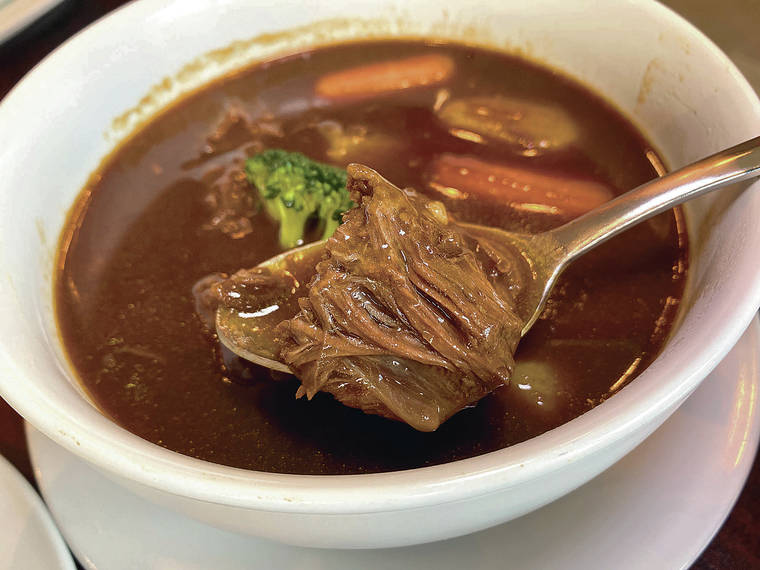The Weekly Eater: Yoshoku reflects merger of Western tradition with Japanese taste

NADINE KAM / SPECIAL TO THE STAR-ADVERTISER
Melty beef stew from Yoshoku Bairin.
I debated whether to write about Yoshoku Ginza Bairin, because of its limited appeal to a general audience.
The restaurant opened early this month next door to sister restaurant Tonkatsu Ginza Bairin, and the people most likely to be drawn to this food will be Japanese expatriates with a nostalgia for the food they grew up with. Next would be those who have either lived in Japan or traveled there extensively enough to develop a taste for Western food reimagined to suit Japan’s perceptions.
That translates to food incorporating a lot of Heinz ketchup, which will tend to make the rest of us think, “Huh?”
As a friend, Japanese blogger Ritsuko Kukonu, put it, “I didn’t think we used so much ketchup until I came here and people told me it’s weird because ketchup is nothing special.”
It works both ways. The Japanese find it grotesque that we have a penchant for mixing wasabi and shoyu into a dipping sauce for sushi, and Kukonu said she was aghast the first time she saw her local boyfriend, now husband, pour shoyu all over his rice.
“I was so shocked,” she said. “If my father saw me doing that he would scold me because in Japan we see rice as precious, and don’t want to ruin it. We understand farmers work so hard to offer the best product to enjoy as is.”
Don't miss out on what's happening!
Stay in touch with breaking news, as it happens, conveniently in your email inbox. It's FREE!
The restaurant’s existence is sure to spark many a conversation about culinary authenticity and cultural appropriation.
It’s a living example of food evolution and colonialism dating as far back as the Meiji Era (1868 to 1912), when Japan opened to the West, and as recently as World War II, when beef once available only to the elite and American rations worked their way onto every family table.
U.S. occupations during the mid-20th century sparked the invention of many dishes we love today, from our own Spam musubi, to Okinawa’s taco rice and South Korea’s army stew, a jjigae incorporating all forms of canned meats, hot dogs and beans. In Korea, the evolution has continued with a fetish for cheese added to anything from spicy gochujang-coated tteokbokki (rice cakes) and pork ribs, to oozy mozzarella at the heart of Korean pork katsu.
So, if we find the Japanese version of Western fusion somewhat weird, who’s to say it won’t become tomorrow’s fave treat?
It’s enough to make woke foodies’ heads spin as they weigh their love for invention and ingenuity against a disdain for the oppression and imperialism that led to these incongruous combinations.
Aiming to expand his company, third-generation tonkatsu master Masaya Shibuya, grandson of Tonkatsu Ginza Bairin founder Nobukatsu Shibuya, wanted to bring yoshoku cuisine here to introduce his beloved Japanese family tradition to the West. He was raised on a diet that was half washoku (Japanese cuisine) and half yoshoku (Western cuisine), and his recipes are more polished versions of dishes his mom regularly prepared for him.
During an interview last month, he explained that in Japan there are mom-and-pop specialty shops that prepare one dish well, but no restaurants that bring all the yoshoku dishes under one roof, making this restaurant, he believes, the first of its kind anywhere.
Locally, yoshoku dishes such as hamburger steak, spaghetti with meat sauce and creamy gratins have been available on menus, but there hadn’t been an attempt to create a dedicated venue for this cuisine. There’s no doubt as to the quality we associate with the Bairin brand, but the food is geared more toward the Japanese palate than a local one.
The dish most frequently associated with yoshoku meals is omurice ($22), the ultimate comfort food of a fried rice-filled omelet. Imagine subbing the shoyu in local-style fried rice with ketchup, to create a flavor more sour than salty. Those with a sense of nostalgia toward this will find it mouthwateringly yummy. I found it one-dimensional, as I like to throw a lot of things into an omelet: breakfast meat, cheese, spinach, mushrooms, whatever. The plainest I could withstand is an adobo rice omelet, packed with the flavor of pork or chicken adobo.
I could make an omelet more to my taste at home for much less money, though not as flawless in appearance.
Similarly, ground beef is stirred with ketchup to make the meat sauce for Bairin’s spaghetti ($23). It’s not bad at all, but plain, and for the price, I’d prefer the Italian versions served at other upscale Japanese restaurants around town.
A seafood macaroni gratin ($24.50) appears to be gloriously creamy and cheesy, but will seem milder than expected to Americans weaned on lots of dairy fat.
Local diners are most likely to be won over by the hamburger steak plate ($26.50) with its thick patty of American wagyu beef and 20% pork, with a sauce of ketchup, tonkatsu sauce and burdock. In this case, the ketchup flavor seemed more sensible, because ketchup goes with burgers, and I remember public school meatloaf with a layer of ketchup baked on top. It just shows how much of our acceptance of foods is shaped by experience.
The telltale sign that this is not an American plate is the presence of just four french fries instead of a mound of them.
My favorite dish was a Melty Beef Stew ($28.50) of American wagyu beef cheeks that indeed did melt on the tongue, so tender that the beef started falling apart as soon as it was spooned out of the demi-glace stew. It doesn’t have a lot of beef, but there’s value in the wagyu and the richness of it all.
It’s worth a visit just to see how one nation has interpreted our food, and how they’re trying to sell it back to us.
YOSHOKU GINZA BAIRIN
255 Beach Walk Ave.
Food: ***1/2
Service: ****
Ambiance: **1/2
Value: ***
>> Call: 200-1109
>> Hours: 11 a.m. to 2:30 p.m. and 5 to 8:30 p.m. daily
>> Prices: About $60 for two without alcohol
Ratings compare similar restaurants:
**** – excellent
*** – very good
** – average
* – below average
Nadine Kam’s restaurant reviews are conducted anonymously and paid for by the Star-Advertiser. Reach her at nkam@staradvertiser.com.





